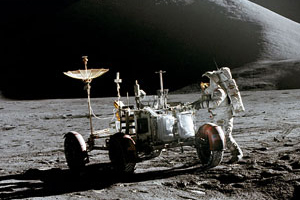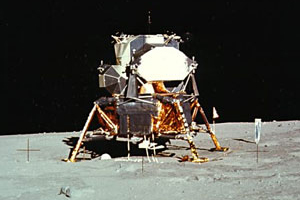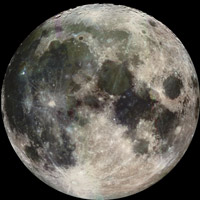The basic work assumption of the "new space powers" is short-term - how to get ahead of the others in the journey to the moon? While the work assumption of the Americans is long-term - what will we do on the moon when we reach it?

A little history
Despite the horrors of three world wars (two hot and one cold), the 20th century made the greatest contribution to the study of space science. The military implications of some of the studies ensured unlimited budgets for the field and the volatile political situation during the century only fueled the statesmen's apprehension and confirmed the need for these developments. And despite the dark military side, most of the military applications also contributed indirectly to civilian areas, which we will talk about in the conclusion of the article.
The launch of the first artificial satellite Sputnik-1 on October 4, 1957 marked the beginning of the space race. On August 17, 1958, it was the Americans who raised the bar and tried to reach the moon with Pioneer-0, the experiment failed. After several more failed attempts by both sides, it was the Russian probe Luna-1 that on January 2, 1959 made a flight towards the moon but a malfunction caused the target to be missed. In the second attempt on September 13, 1959, the moon was captured by Luna-2 and the Russian probe became the first man-made object to reach the lunar surface.

The Russian achievements in space stood out against the many failures of the Americans, the peak occurred on April 12, 1961 when the Vostok-1 spacecraft was launched with the first man in space - Yuri Gagarin.
In the second part of the decade, the Americans began to reduce gaps and accumulate more impressive achievements than the Russians, but it was already clear to everyone that after Sputnik and Gagarin's flight - the next significant achievement would be a manned mission to the moon.
the race to the moon
A flight to the moon includes many critical stages: launching a vehicle into space, flying towards the moon, lowering a spacecraft to the ground, launching the spacecraft back into space, flying to Earth, and landing safely. Each step entails many problems, so the Russians and the Americans began feverish preparations. The work teams did everything to reduce the margin of error and the decision makers did not spare the means and budgets to achieve the goals.
The first (successful) soft landing on the Moon was made by Luna-9 in 1966, followed by several American soft landings on the Survivor spacecraft. At the same time, the Apollo program launched manned missions to the moon to perform orbits around the moon in order to test systems and the functioning of various devices.

July 20, 1969 was the date when the Americans did the unbelievable, for the first time humans landed on the moon!! Apollo 11 made history and Neil Armstrong became the first man to walk on the moon.
The achievement pushed NASA to send more people to the moon (a total of 6 missions), while the defeated Russians abandoned the manned option and their future missions included robotic spacecraft aimed at collecting soil samples and returning them to Earth.
The silent decades
Everyone understood that it would not be possible to make significant achievements of a similar magnitude since manned flight to distant planets is too dangerous, so the 70s were devoted to robotic exploration of planets. In the 80s and 90s, robotic research was expanded and capabilities were developed for a long-term stay in space as part of the various space stations assembled near the Earth.
It can be said that after about 20 years of intimate research, the moon was abandoned because the competition between the superpowers moved to other areas. 1972 was the last year a man (Eugene Cernan) set foot on the moon. And 1976 was the last year that any probe hovered around the moon (Luna-24).
The arena opens to more players

During the 80s, Japan underwent accelerated development. Investments in an independent space program brought great prestige to the country, promoted the technological knowledge of the population and brought honor and pride to the people. After a successful asteroid exploration program, it was decided that the next target was the moon. In 1990, after 14 quiet years in the lunar arena, the Japanese spacecraft Hiten (Flying Angel) was launched to explore the moon.
The Americans could not afford to be left out of the picture, so in 1994 the Clementine Mikapet was launched and in 1998 the Mikapet Lunar-Prospector.
The European Space Agency entered the picture in 2003 with the launch of the Mekapet Smart-1, which resulted in increased interest in our nearest neighbor.
Accelerated economic development in Asia introduced more competition into the space field, and the renewed interest in the moon accelerated the competition between the Asian players. Japan was the first launch the circle Selen-Kaguya In September 2007, after her a routine China you Shenja-1 In October 2007, and India is going to launch the Mekpet Chandrian during the coming months. Now, when everyone is talking about going back to the moon, the Americans and the Russians have also presented plans to launch new orbiters around the moon.
It should be noted that the competition between the various countries is a technological competition with the aim of proving that they have the knowledge and technical tools to launch tools to the moon. There are enormous knowledge gaps in the space capabilities of the various countries, the return to the moon should reduce most of these gaps. Beyond that, launching orbits to the moon is said to have already been done in the past by some of the players, restoring the abilities will not achieve achievements therefore launching orbits is a preliminary step to ambitious manned missions designed to present new achievements. The Chinese, for example, have proven that they can bring a person into space on their own andin their intention To show more achievements, first they will launch orbiters to the moon, and in later stages robots will land on the moon and finally humans will repeat soil samples.
The motivations of the various actors
While the basic premise of the "new space powers" is how to get ahead of the others in the journey to the moon? The working assumption of the Americans is what we will do on the moon when we get there. Although international competition plays a central role in the return to the moon craze, the US has proven its ability in the past so that their return to the moon must produce new achievements to perpetuate their superiority over the other players.
Below are the motivations of the different countries:
India: India is the second most populous country in the world (over 1.1 billion inhabitants). Many see it as a power that has not yet awakened and intends to do everything in order to obtain the status of a full-fledged power - an independent space program will certainly bring it closer to this goal. Another essential facet is its war with Pakistan. The cat-and-mouse games in technological progress have moved from the field of ballistic missiles to the field of space. Sending spacecraft to the moon will prove that Indian capabilities exceed Pakistan's capabilities.
China: China is a country with the largest population in the world (over 1.3 billion inhabitants) and is one of the largest economic powers in the world (it is predicted that it will surpass the USA in the coming decades). As the state's influence grows, it is threatened more and more by external factors that do not wish to share power and influence with it in the international arena. The Chinese space program is extremely ambitious, in 2003 it became the third power to launch a man into space and intends to continue promoting space research. It is true that China prefers to invest in the development of military space capabilities over investments in an unnecessary adventure on the moon, but achieving the goal will bring it great prestige in the world, develop advanced technologies, acquire knowledge for the local population and indirectly also contribute to its military capabilities.
Japan: Since World War II, Japan has been an essentially pacifist country. Without a regular army, most of its investments are directed to the population and the economy. Japanese industry invests heavily in R&D, its population loves innovations and the government allocates budgets for innovative projects. The space sector is financed by the state in cooperation with the local industry and thus the state creates an advantage for Japanese companies in an industry that is going to generate hundreds of billions in the coming decades. Achieving advanced space capabilities with the participation of civil industry advances the government's goals.
Russia: Since the dissolution of the USSR, Russia has not come to terms with losing its influence in the world and in recent years it has been working in a variety of areas to regain its position as a significant force to be reckoned with. It is true that it has already proven that it is capable of reaching the moon and the current leadership prefers to invest money in the military and the economy, but the country cannot stand by when all the powers are marching towards the moon. The first country to conquer space simply cannot be left behind especially when its space program serves as the backbone of the global launch industry. Russia must prove that it does not rely on old technologies, a mission to the moon will help shake this image.
U.S: As a world power and leading the way, the USA cannot help but act. It will try to reproduce old achievements to show that it is still the dominant force in the world and create new achievements that will prove its technological superiority. At stake is the prestige of the largest and budgeted space agency in the world, NASA needs to prove that the huge budgets invested in the agency bring results. If with the technology of the 70s they managed to reach the moon, NASA must do it better and faster with today's technology. At the same time, their situation is different from the other players, while the others are in a race just to reach the moon, the Americans are planning for a longer term - on the agenda are options such as establishing a research laboratory for a long-term stay, establishing manned space telescopes that will reveal the secrets of the universe, establishing mines for mining minerals, or any Another groundbreaking action.
(The different countries have a wide variety of considerations that motivate them to invest money in developing space programs and launching orbiters to the moon, I refrained from stating additional reasons to shorten the article, but I would be happy to discuss it in the comments section)
Summary
The various countries taking part in the renewed race to the moon are each doing so for their own reasons, but all are trying to prove that they can do it. The most important point, at least for me, is that after the race is over, the technological and technical knowledge will reach a wide variety of engineers from different countries. Once the governments stop supporting these projects, these engineers will have to integrate into civilian industries and use the knowledge they have acquired. Or then we will start to see the return on investment in the space programs.
More on the subject on the science website

14 תגובות
I have to do a mini space exploration job on the moon
Daniela,
Try the following link:
http://he.wikipedia.org/wiki/הירח
I would like to know what the size of the moon is because I have homework so I need someone to answer me by 20:00 so it's actually on Saturday today 20.9.08/XNUMX/XNUMX
Please it's very urgent!
I also have no sympathy for personality cults of any kind.
But it is worse to live on deep inner lies.
And you see the results every day.
The moon is only a reflection of your souls - a vault of virtual memories only.
There are no wars when it is clear.
There are no wars in a good heart.
You are the ones who influence the thoughts of the other nations with your low thoughts. You are radiating
For better or for worse for the whole world. - right here -
You must here - on this site - change the channel for the better in your inner circle...
Hugin: Take constructive responsibility with clear and clean thinking. - It is possible and necessary!
You are the ones who are commanded to be a light to the good nations. And not without black and dark holes.
Yours. Release her and live in a different vibration.
Take care of yourselves - inside the heart.
It's not hard. And it pays off.
Itzik,
The Russians do not force a cold war any more than the Americans force it. Check which country has military bases almost everywhere in the world and which country is invading other media for oil and hegemony.
And no, I have no sympathy for Russian non-democracy and Putin's cult of personality
What about us, where is Israel working on the race to the moon? Shouldn't we beat Iran in the race to the moon?
And to Itzik, I know many people who have new computers that cost them thousands of shekels, great computers, but all they do with them is run the Rose. It is not enough that you have the computing power, the thing is to know how to use it correctly! Besides, getting to the moon is not a task that will take software programming on a computer and now we have arrived, we need to build a spaceship that will withstand unusual pressures and temperatures and conditions that if you haven't been there and haven't conducted experiments you can't understand it.
Itzik,
In recent decades, the matter of the moon has been quite deliberately neglected, in my opinion the "peak" of excitement has also decreased a lot since the landing of the first man on the moon and this is not as exciting as it used to be, most of the energies in terms of exploring the planets have been put on missions based on probes and not on manned missions to the planets .
The Russians and the Americans have the most knowledge in terms of manned missions and as I know the Russians even have a slight advantage in this area in terms of understanding the needs and solutions required for astronauts.
Today there are plans for manned missions to Mars and of course back to the Moon, let's not forget the International Space Station which is a great achievement in the making.
two things
1. Should we welcome the next cold war that Russia (I almost wanted to write the USSR) imposes on us, if only to inject new energy into the space programs of the various countries?
And also for the other technological industries?
2. The flight to the moon was carried out with technology and computing power much weaker than that found in our family cars. What's going on ? Where are things stuck? With the computing power we have today, we should have already settled on Mars.
In my opinion, the answer is that not everything in these computers needs to add the rest of the human spirit, the vision and the desire, something that disappeared in the race for the million.
And maybe it's good that the cold war returns on low heat, if only to inject an incentive that is not positive but still an incentive.
It's really not clear to me where the silent inner roar that emanates from within my being comes from. And this place wants
To say to all those who are still in the competition who is more in matters of space and its conquest, go go. But from now on it will be
Go without returning. Take with you blankets and all equipment for the time of Mitzvah and there you will stay forever!!!!!!
You are really no longer welcome here on earth. You have finished to the fullest - a cycle of white and red.
Hugin: Without any name. Nothing. Nothing. Without a hint of responsibility. And a huge deletion!
Red line.
NASA does holy work, it is true that a lot of money is invested, but there are large donations - of course in the immediate sense it is the exploration of the universe, but in addition there are many technologies from all kinds of different fields, including medicine that came as a result of NASA's developments and research, so that NASA has Implications for more areas of life than cosmology - astrophysics.
Not to mention the development of the human race without the amounts of money that are poured into research of its kind in the world, the development would have been slower in the medium-long term.
With you know why don't you tell
Alak explored the moon. Everything NASA tells is just lies. There is no connection between the fake information presented by NASA and the *truth* which is very different.
On August 14 we will all find out the truth.